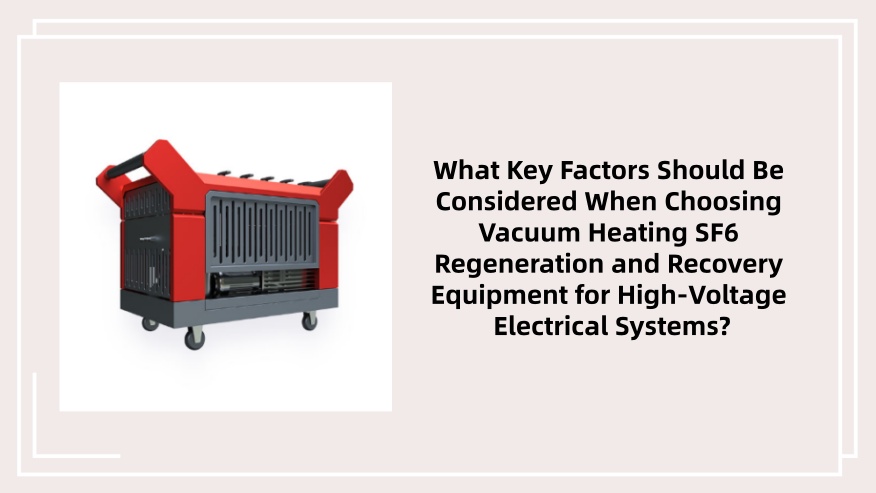
- SF6 Relations
- 2025-09-25
Sulfur hexafluoride (SF6) is a critical insulating and arc-quenching medium in high-voltage electrical equipment, thanks to its excellent dielectric properties and thermal stability. However, SF6 is also one of the most potent greenhouse gases—with a global warming potential (GWP) 23,900 times that of CO2 over a 100-year period—and has an atmospheric lifetime of over 3,200 years. This makes proper SF6 management non-negotiable for industries aiming to reduce carbon footprints and comply with global environmental regulations (such as the EU’s F-Gas Regulation). Among the technologies addressing this challenge, vacuum heating SF6 regeneration and recovery equipment stands out as a game-changer, enabling efficient gas recycling and minimizing waste.
Why Vacuum Heating Technology is Essential for SF6 Regeneration and Recovery
Traditional SF6 recovery methods often struggle with removing impurities (e.g., moisture, decomposition byproducts like SO2F2, SOF2, and particulate matter) that accumulate during equipment operation. These impurities degrade SF6’s performance: moisture can cause electrical breakdown in high-voltage systems, while decomposition products corrode equipment components and reduce insulation efficiency. Simply recovering and storing contaminated SF6 is ineffective—recycling (regeneration) is necessary to restore the gas to its original purity.
This is where vacuum heating technology adds unique value. Vacuum heating SF6 regeneration and recovery equipment combines two critical functions:
Vacuum-based recovery: Creates a low-pressure environment to extract SF6 from electrical equipment (e.g., circuit breakers, transformers, GIS) efficiently, even from hard-to-reach compartments. Vacuum reduces the boiling point of SF6, ensuring complete extraction without leaving residual gas.
Heated regeneration: Uses controlled heating (typically 80–120°C) in a vacuum chamber to vaporize moisture and volatile impurities, which are then filtered out via specialized adsorbents (e.g., molecular sieves for moisture, activated alumina for acidic byproducts). The vacuum prevents recontamination by isolating the gas from atmospheric air during the process.
Unlike conventional recovery systems that rely on high pressure (which can compress impurities into the gas stream), vacuum heating ensures that SF6 is purified to meet international standards (e.g., IEC 60376), making it reusable in critical electrical applications.
Core Advantages of Vacuum Heating SF6 Regeneration and Recovery Equipment
For industries like power generation, transmission, and manufacturing (which rely heavily on SF6-based equipment), investing in this technology delivers multiple benefits:
1. Environmental Compliance and Carbon Reduction
By regenerating and reusing SF6 instead of venting or discarding it, vacuum heating SF6 equipment directly cuts greenhouse gas emissions. A single unit can recover up to 99.9% of SF6 from used equipment, with regeneration rates that restore purity to >99.8%. This helps businesses meet regulatory targets (e.g., the U.S. EPA’s SF6 emission limits) and avoid fines for non-compliance.
2. Cost Savings
SF6 is a high-cost gas—purchasing new SF6 can account for a significant portion of maintenance budgets. Vacuum heating regeneration and recovery eliminates the need to buy new gas for every equipment service cycle. For a mid-sized power plant, this can translate to annual savings of \(50,000–\)150,000, depending on SF6 usage volume. Additionally, the equipment reduces disposal costs for contaminated gas, which requires specialized handling to avoid environmental harm.
3. Equipment Longevity and Reliability
Contaminated SF6 accelerates wear and tear on electrical components, leading to frequent breakdowns and unplanned downtime. By restoring SF6 to high purity, vacuum heating systems protect critical assets (e.g., GIS units, which cost millions of dollars) from corrosion and electrical failure. This extends equipment lifespan by 10–15% and reduces maintenance frequency, improving overall operational efficiency.
4. Portability and Versatility
Modern vacuum heating SF6 regeneration and recovery equipment is designed for on-site use—compact, mobile units can be transported to power substations, wind farms, or manufacturing facilities. They handle a range of SF6 volumes (from small circuit breakers to large transformers) and work with different gas pressures, making them suitable for diverse industrial applications.
Key Considerations When Selecting Vacuum Heating SF6 Equipment
To maximize efficiency and ROI, businesses should evaluate the following factors:
- Purity Performance: Ensure the equipment can achieve SF6 purity levels of ≥99.8% (meeting IEC 60376) and remove impurities like moisture (to <5 ppmv) and acidic byproducts (to <0.1 ppmv).
- Recovery Rate: Look for systems with a recovery rate of ≥99.9% to minimize gas loss.
- Energy Efficiency: Choose units with low power consumption, especially for continuous operation—features like variable-speed compressors and insulated heating chambers reduce energy costs.
- Safety Features: SF6 is non-toxic but can displace oxygen in confined spaces. Opt for equipment with pressure relief valves, oxygen sensors, and leak detection systems to ensure operator safety.
- After-Sales Support: Select manufacturers that offer maintenance services, spare parts (e.g., adsorbents, filters), and training for on-site teams.
The Future of SF6 Management: Vacuum Heating as a Standard
As global environmental regulations tighten and industries prioritize sustainability, vacuum heating SF6 regeneration and recovery equipment is becoming a standard tool for responsible gas management. It not only addresses the environmental impact of SF6 but also enhances operational efficiency and cost-effectiveness for businesses. For organizations looking to balance performance with sustainability, investing in this technology is a strategic choice—one that aligns with long-term environmental goals and regulatory compliance.
In summary, vacuum heating SF6 regeneration and recovery equipment is more than a piece of machinery: it’s a solution that bridges the gap between industrial productivity and eco-friendly practices, ensuring that SF6 continues to support critical electrical systems without harming the planet.
Leave a Reply